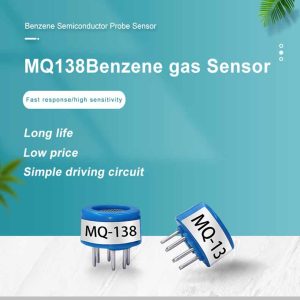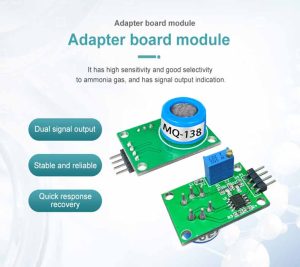Air pollution is a global environmental challenge and a major threat to public health. Understanding and monitoring air quality is crucial for effective pollution control and safeguarding human well-being. In recent years, advancements in gas sensor technology have revolutionized air quality monitoring, providing accurate and real-time data on pollutant levels. In this article, we will explore the power of gas sensors in advancing air quality monitoring and the benefits they bring to environmental protection and human health.
Gas Sensors: A Key Tool for Air Quality Monitoring:
Gas sensors play a vital role in measuring and

detecting different types of air pollutants. These sensors are designed to detect specific gases and provide quantitative data on their concentration levels. Some common air pollutants monitored by gas sensors include particulate matter (PM), carbon monoxide (CO), nitrogen dioxide (NO2), ozone (O3), sulfur dioxide (SO2), and volatile organic compounds (VOCs). By continuously monitoring these pollutants, gas sensors enable authorities to assess air quality, identify sources of pollution, and implement effective mitigation strategies.
Real-Time Data Collection and Analysis:
One of the significant advantages of gas sensors is their ability to collect real-time data on pollutant concentrations. Traditional
air quality monitoring methods involved manual sampling and laboratory analysis, which were time-consuming and provided delayed results. Gas sensors, on the other hand, offer continuous monitoring, allowing for immediate detection and response to changes in air quality. Real-time data collection enables authorities to track pollutant trends, identify pollution hotspots, and make informed decisions regarding pollution control measures.
Wireless Connectivity and IoT Integration:
Modern gas sensors are equipped with wireless connectivity capabilities, enabling seamless transmission of data to centralized monitoring systems. This connectivity allows for remote monitoring of air quality over large geographical areas, including urban centers and industrial regions. Moreover, gas sensors can be integrated into Internet of Things (IoT) platforms, enabling real-time data visualization and analysis. This integration enhances data accessibility, improves data management, and facilitates collaboration among stakeholders, such as government agencies, researchers, and environmental organizations.
Precision and Accuracy:
Gas sensors have witnessed significant advancements in terms of precision and accuracy. These sensors can detect and measure pollutant levels at very low concentrations, ensuring reliable air quality monitoring. Improved accuracy is crucial for understanding the health risks associated with various pollutants and allows for accurate assessment of compliance with air quality standards and regulations. Accurate data provided by gas sensors helps authorities identify pollution sources, implement targeted control measures, and evalu
ate the effectiveness of pollution reduction strategies.
Portable and Mobile Monitoring Solutions:
Gas sensors are available in various sizes and formats, including portable and mobile options. These portable sensors can be easily carried and deployed in different locations, allowing for on-the-spot air quality assessments. Portable gas sensors are particularly useful in monitoring indoor air quality, construction sites, or areas affected by specific pollution sources. Mobile mo
nitoring solutions, such as sensor-equipped vehicles or drones, provide flexibility in monitoring air quality across vast areas or hard-to-reach locations.
Early Warning Systems and Health Protection:
Gas sensors serve as early warning systems for detecting high pollutant levels and potential health risks. Elevated levels of certain pollutants, such as carbon monoxide or particulate matter, can lead to respiratory problems, cardiovascular diseases, and other adverse health effects. Gas sensors can trigger alerts or warnings when pollutant concentrations exceed safe thresholds, allowing authorities to take immediate action to protect public health. Timely interventions, such as issuing health advisories or implementing pollution reduction measures, can prevent or mitigate the harmful effects of air pollution on vulnerable populations.
Citizen Engagement and Awareness:
Gas sensors also empower citizens to actively participate in monitoring air quality and raising awareness about pollution issues. With the availability of portable and affordable gas sensors, individuals can monitor air quality in their surroundings and contribute data to citizen science initiatives. Citizen engagement in air quality monitoring improves community awareness, fosters a sense of ownership, and encourages collective action for pollution control. Moreover, accessible air quality data empowers individuals to make informed choices about their daily activities, such as outdoor exercise or route planning, to minim
 : +86 155 8830 2704
: +86 155 8830 2704 : jxdziot@gmail.com
: jxdziot@gmail.com
